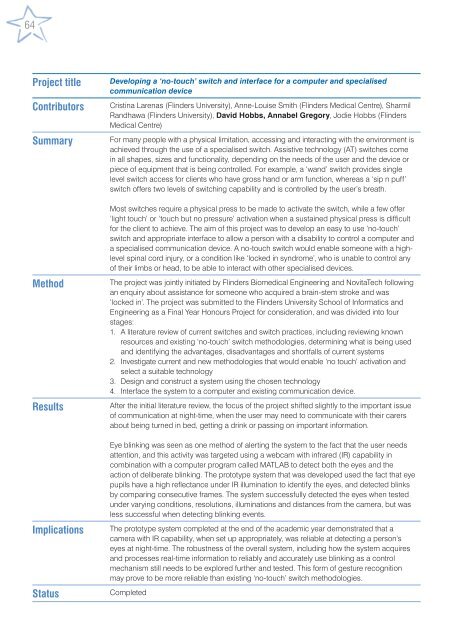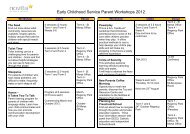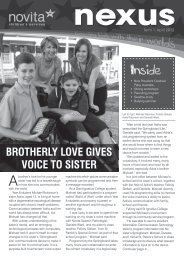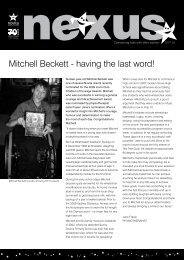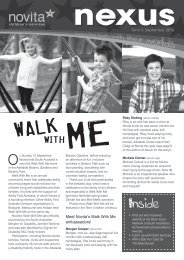Novita Research Report - 2004 to 2007 - Novita Children's Services
Novita Research Report - 2004 to 2007 - Novita Children's Services
Novita Research Report - 2004 to 2007 - Novita Children's Services
- No tags were found...
Create successful ePaper yourself
Turn your PDF publications into a flip-book with our unique Google optimized e-Paper software.
64Project titleContribu<strong>to</strong>rsSummaryMethodResultsImplicationsStatusDeveloping a ‘no-<strong>to</strong>uch’ switch and interface for a computer and specialisedcommunication deviceCristina Larenas (Flinders University), Anne-Louise Smith (Flinders Medical Centre), SharmilRandhawa (Flinders University), David Hobbs, Annabel Gregory, Jodie Hobbs (FlindersMedical Centre)For many people with a physical limitation, accessing and interacting with the environment isachieved through the use of a specialised switch. Assistive technology (AT) switches comein all shapes, sizes and functionality, depending on the needs of the user and the device orpiece of equipment that is being controlled. For example, a ‘wand’ switch provides singlelevel switch access for clients who have gross hand or arm function, whereas a ‘sip n puff’switch offers two levels of switching capability and is controlled by the user’s breath.Most switches require a physical press <strong>to</strong> be made <strong>to</strong> activate the switch, while a few offer‘light <strong>to</strong>uch’ or ‘<strong>to</strong>uch but no pressure’ activation when a sustained physical press is difficultfor the client <strong>to</strong> achieve. The aim of this project was <strong>to</strong> develop an easy <strong>to</strong> use ‘no-<strong>to</strong>uch’switch and appropriate interface <strong>to</strong> allow a person with a disability <strong>to</strong> control a computer anda specialised communication device. A no-<strong>to</strong>uch switch would enable someone with a highlevelspinal cord injury, or a condition like ‘locked in syndrome’, who is unable <strong>to</strong> control anyof their limbs or head, <strong>to</strong> be able <strong>to</strong> interact with other specialised devices.The project was jointly initiated by Flinders Biomedical Engineering and <strong>Novita</strong>Tech followingan enquiry about assistance for someone who acquired a brain-stem stroke and was‘locked in’. The project was submitted <strong>to</strong> the Flinders University School of Informatics andEngineering as a Final Year Honours Project for consideration, and was divided in<strong>to</strong> fourstages:1. A literature review of current switches and switch practices, including reviewing knownresources and existing ‘no-<strong>to</strong>uch’ switch methodologies, determining what is being usedand identifying the advantages, disadvantages and shortfalls of current systems2. Investigate current and new methodologies that would enable ‘no <strong>to</strong>uch’ activation andselect a suitable technology3. Design and construct a system using the chosen technology4. Interface the system <strong>to</strong> a computer and existing communication device.After the initial literature review, the focus of the project shifted slightly <strong>to</strong> the important issueof communication at night-time, when the user may need <strong>to</strong> communicate with their carersabout being turned in bed, getting a drink or passing on important information.Eye blinking was seen as one method of alerting the system <strong>to</strong> the fact that the user needsattention, and this activity was targeted using a webcam with infrared (IR) capability incombination with a computer program called MATLAB <strong>to</strong> detect both the eyes and theaction of deliberate blinking. The pro<strong>to</strong>type system that was developed used the fact that eyepupils have a high reflectance under IR illumination <strong>to</strong> identify the eyes, and detected blinksby comparing consecutive frames. The system successfully detected the eyes when testedunder varying conditions, resolutions, illuminations and distances from the camera, but wasless successful when detecting blinking events.The pro<strong>to</strong>type system completed at the end of the academic year demonstrated that acamera with IR capability, when set up appropriately, was reliable at detecting a person’seyes at night-time. The robustness of the overall system, including how the system acquiresand processes real-time information <strong>to</strong> reliably and accurately use blinking as a controlmechanism still needs <strong>to</strong> be explored further and tested. This form of gesture recognitionmay prove <strong>to</strong> be more reliable than existing ‘no-<strong>to</strong>uch’ switch methodologies.Completed


